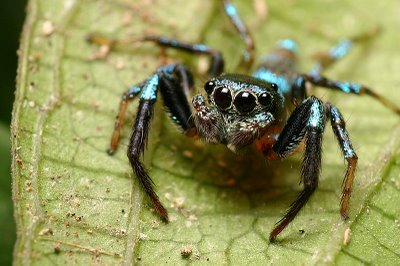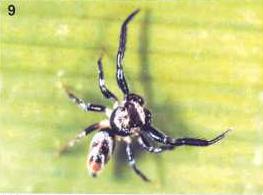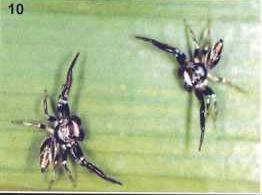Thania bhamoensis Thorell,an iridescent jumping spider species , commonly known as fighting Spiders is know for its aggressive behaviour towards its males counterpart. In the picture below an example of two male fighting spiders .
I used to keep male fighting spiders (Thania bhamoensis) during my secondary school days and I would bring them to school every day to challenge my peers’ spiders. I was very amazed about these spiders threat display during the fighting . And this curiousity have partly spur me to take up LSM1303 in NUS to understand more about animal behaviour. During this couse of study, I learn about these spiders fighting engagement process and also have a better understanding of their sequence of action involved during a fight.
I have found that the reason for these spiders level high level of aggression is due to reproductive purposes. These spiders reproductive success depends on the access to prospective mates, and competition between male for mates is common in nature and conspecific often communicate during the agonistic interaction through threat displays.
Normally when the male spider are not interacting with another male spider , it resumed a normal posture with its stationary legs arched towards its body( normal mode) as shown in Pic 1.
(Pic 1 : Closeup view of male Fighting Spider in a normal state.)

Coutesy of Alan Photography
However, when it encounter a male conspecific as far as 14cm , its natural instinct is to face each other with a defensive and alert stance and approach each other . In this Stance, the palp are spread open to send visual cues to opponent to show off its size and hence prowess(Pic 2) (Daiqin.et al,2002). In some cases, opponent may sense the threat and decamp ( escape).

Coutesy of Daiqin li.et al. 2002
( Pic 2: Showing off PROWESS!)
But in some cases, opponent may persist and approach the hostile spider. Usually in such cases, both spiders are seemingly equal size or slightly different in size and a fight will most likely breakout between them. In the picture below(Pic 3), it shows two spider with fully extended palp ready to engage in a battle. This stance is to fully exaggerate their size and intimidate the opponent before the fight(Daiqin.et al,2002).. The spiders in this position will slowly inch in a forward and backward motion towards or away from each other while maintaining their sparring stance. However, usually the primitive spider will remain stationary keeping visual contact with the invading spider while the invading spider approach the primitive spider (Daiqin.et al,2002).
Pic 3: FACEOFF!!!
Next, when they are finally within a body length from each other , their palp are arched and their abdomen are tilted even more towards one side( pointing up or down) and the resulting position is that both the spiders appear elevated rather than in a flat position. From this distance, one or both spider will moved closer together and paused momentarily face to face (Pic 4) and embrace to engage in a fight.
(Pic 4: Standby mode! Ready to engage anytime. )
Finally, in the embrace position, both spider in such close physical proximity starts to grapple each other and start pushing each other. Both spiders push their face together and move their legs forward towards each other so that they are interlocked (Pic 5)
(Pic 5: Target locked on! Fight!)
In this process of sparring, tactile cue are used to transmit information about the contestant’s strength and endurance( Rashid. et al, 1992) This allow the spider to assess it’s opponent prowess and decide whether it could win the fight. The fight usually break off when one of the spider decamp (escape) or when the other party is killed (rare cases). The spider will emerge victorious when his opponent decamp.
Reflection:
Although watching Fighting Spider fight is interesting, we should not watch this fight as a form of pleasure. When fight break out, these spiders may get injured or may be killed, hence it is cruel to induce fight between these spiders just for our curiosity and leisure or for gambling purpose.
As mentioned, I used to keep fighting spider as pet. This was because I was fascinated by its fighting behaviour. I often bring them to challenge my friend spider for the sake of fun. However in one uneventful fight, I lost my favourite spider named “ Bison” when it was killed during a fight. I got so sad and decided to gave up the rest of my spider . It was then that I decided human-induced animal fight is a very cruel sport.
References:
Daiqin, l. Seow, H, Y. & Wee, K, H. 2002. ‘Rivet-like nest building and agonistic behaviour of Thiania Bhamoensis, an iridescent jumping spider’. The Raffles Bulletin of Zoology 50(1) :143-151
Secondary reference:
Rashid, N. Y. & M. S. Azirun, 1992. Agonistic behaviour of male fighting spiders (Thania bhamoensis). Nature Malaysia, 17: 121-123
Picture:
URL:http://www.flickr.com/photos/tropicaljantie/2626728707/ ( Accessed on 3 April 2010)
URL: http://www.flickr.com/photos/alan_projects/4176084913/( Accessed on 3 April 2010)



